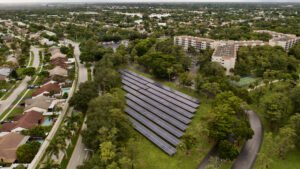Community Solar Projects and Solar Grading:

Community solar projects and solar grading are both relevant aspects of the solar energy landscape. Let’s explore each concept:
Community Solar Projects:
Definition:
Community solar, also known as shared solar or solar gardens, refers to solar power installations that are owned, operated, and shared by multiple community members. It allows individuals or businesses to benefit from solar energy without having to install solar panels on their own properties.
Benefits:
- Accessibility: Enables people who may not have suitable rooftops or financial means to participate in solar energy.
- Cost Sharing: Participants share the costs and benefits of the solar installation.
- Environmental Impact: Reduces reliance on traditional fossil fuels, contributing to a cleaner environment.
Key Components:
- Subscription Model: Participants typically subscribe to a portion of the solar energy generated and receive credits on their utility bills.
- Remote Ownership: Solar panels may be located on a separate site, and participants may own a share of the project.
Challenges:
- Regulatory Hurdles: Depending on the region, regulatory frameworks may present obstacles to community solar development.
- Land Availability: Finding suitable land for large solar installations can be a challenge in some areas.
Solar Grading:
- Definition: Solar grading involves assessing the potential of a specific location for solar energy generation. It considers various factors to determine the feasibility and efficiency of solar installations.
- Factors Considered:
- Solar Irradiance: The amount of sunlight a location receives.
- Shading: The presence of obstructions (buildings, trees) that may cast shadows on solar panels.
- Tilt and Orientation: The angle and direction of solar panels to optimize sunlight capture.
- Temperature: Solar panels perform better in cooler temperatures.
- Tools and Technologies:
- Solar Maps: Geographic information systems (GIS) and solar maps help evaluate solar potential in specific regions.
- Remote Sensing: Satellite imagery and aerial surveys aid in assessing shading and land characteristics.
- Importance:
- Solar grading is crucial for optimizing the performance of solar installations.
- It helps investors, developers, and policymakers make informed decisions about the viability of solar projects.
- Advancements:
- Ongoing technological advancements, such as improved forecasting models and AI applications, contribute to more accurate solar grading.

Учимся готовить с нуля: простые рецепты для начинающих
домашние рецепты http://www.brkgrp.ru .
Купить надежную кпп для спецтехники с гарантией качества: Доверьтесь профессионалам
кпп экскаватора погрузчика https://www.xn—–klcfasajgfzrae3as6cp0o.xn--p1ai/ .
Услуги фулфилмент для маркетплейсов: максимизируем ваш рост
фулфилмент https://fulfilment-moskva77.ru .
Быстрое приготовление еды: вкусные решения для суетливых дней
что приготовить кушать https://www.dishes1.ru .
Сохраните счет за воду точным: поверка счетчиков воды
поверка водосчётчиков https://poverka-shetchikov-vodi.ru/ .
Улучшаем эффективность строительства с помощью винтовых свай: преимущества для застройщиков
погружение винтовых свай расценка https://www.vintoviye-svai.ru/ .
Бухгалтерские услуги в Москве для предприятий: как повысить эффективность
бухгалтерские услуги прайс лист https://buhgalterskie-uslugi-495.ru .
Вывод из запоя: первый шаг к новой жизни без алкоголя
вывод из запоя анонимно http://www.vyvod-iz-zapoya663.ru .
Дипломы с доставкой до двери: Удобство в каждом заказе
купить диплом вуза https://kupit-diplom01.ru .
Поверка счетчиков воды: какие изменения в законодательстве
поверка счетчик воды http://poverkaschetchikovvody1.ru/ .
Диплом о высшем образовании: Купить онлайн и сэкономить время и усилия
высшее образование купить диплом http://dipls-w.ru/ .
Продвижение сайтов: интеграция с email-маркетингом
продвижение сайта заказать https://www.prodvizhenie-sajtov-viz.ru/ .
Организация медосмотров в крупных компаниях: Логистика и управление
медицинские осмотры где можно пройти https://www.profosmotry-495-el.ru/ .
Эксплейнеры и вебинары: Как сочетать для максимального эффекта
объясняющее видео объясняющее видео .
Уфанет и IPTV: телевидение нового поколения
тарифы уфанет в уфе http://www.ufanet-podklyuchit.ru/ .
Поддержка при выводе из запоя: Шаги к выздоровлению
вывод из запоя цены http://www.vyvod-iz-zapoya112.ru .
Швейная машинка: выбор между брендами Brother, Singer, Аврора, Тойота или Janome
швейные машинки http://sewing-machines2.ru/ .
Как обставить дом из бруса: советы по дизайну интерьера
строительство домов из бруса в москве http://www.doma-iz-brusa-pod-klyuch1.ru .
Пансионат для пожилых с профессиональным психологическим сопровождением
частный пансионат для пожилых людей pansionaty-dlya-pozhilyh1.ru .
Мебельный поролон с бесплатной доставкой: Лучшее предложение
жесткий поролон vinylko17.ru .
Модульные кухни в Новосибирске: выбор современных хозяев
модульные угловые кухни новосибирск модульные угловые кухни новосибирск .
Вывод из запоя с последующей поддержкой: полный путь к излечению
вывод из запоя самара https://www.vyvod-iz-zapoya114.ru/ .
Где лучше взять срочный займ без паспорта: обзор сервисов
онлайн займ на карту без фото паспорта онлайн займ на карту без фото паспорта .
Дом престарелых: индивидуальный подход к уходу за каждым пожилым
дом для пожилых москва https://www.doma-prestarelyh1.ru .
Скорость и надежность: отсновные преимущества интернета от Уфанет
уфанет ufanet-tarify.ru .
Винный магазин: купить вино для настоящих ценителей
где можно купить вино xn—-1-fdd2ack2aje8aj4j.xn--p1ai .
Купить вино в Москве: вкусное, недорогое и с хорошими отзывами
качественное вино купить https://www.xn—-1-fdd2ack2aje8aj4j.xn--p1ai/ .
Тур в Мурманск на китов: посещение Териберки в рамках экскурсий
посмотреть китов в россии туры https://tur-v-murmansc-na-kitov.ru/ .
Как провести лето в Мурманске: лучшие туры и экскурсии
экскурсии в мурманске летом 2024 http://www.murmansk-ecskursii-letom.ru/ .
Керамические ножи: острота и стиль на вашей кухне
нож складной купить http://www.wibe-industrial.ru/ .
Выбор профессионалов: премиальные ножи в одном месте
ножи ручной работы https://siniilos.ru .
Balancing CPU Load with the Best Optimizers: A How-To Guide
how to optimize cpu http://www.cpu-optimization-app.com/ .
Оптимизация инвестиций: Структурируйте портфель для максимальной выгоды
как научиться инвестировать https://www.100topseries.com/ .
Долгосрочные инвестиции на финансовом рынке: Как оставаться в плюсе
международный финансовый рынок https://www.academia-press.ru/ .
Виагра купить по выгодной цене: Специальные предложения на оригинальный препарат
силденафил купить http://www.viagrshop-hot1.ru/ .